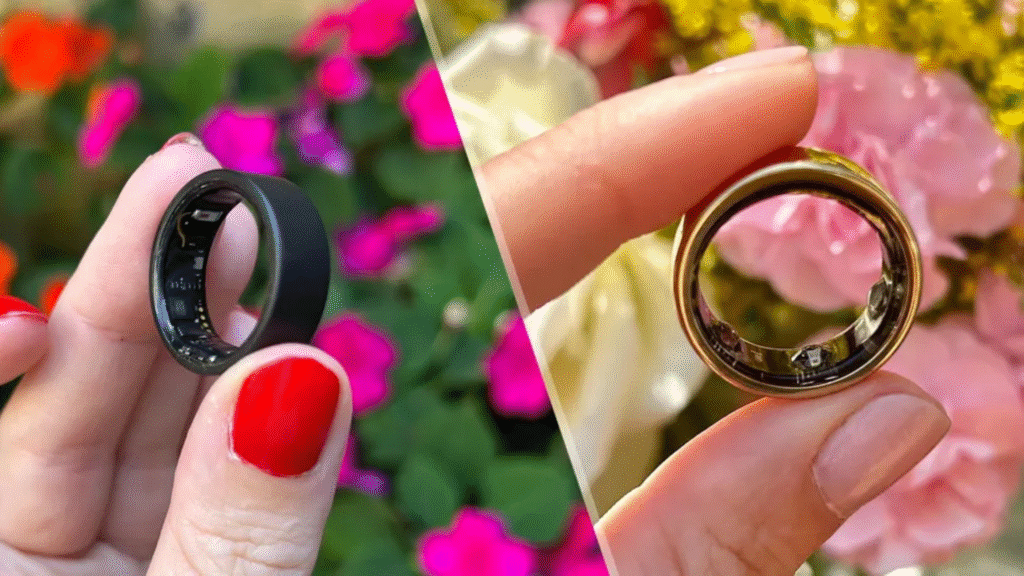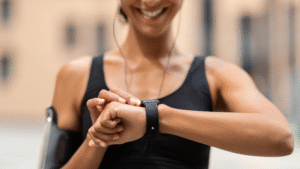Smart rings like the Oura and Ultrahuman AIR track your heart rate, sleep, and activity from a discreet ring on your finger. Users often wonder: which one is more accurate? Both use LED sensors and motion detectors to measure metrics (heart rate, HRV, skin temperature, sleep stages) but they differ in design and algorithms. Here’s a rundown of each device, how they compare, and what reviewers say about accuracy.
Design, Sensors & Fit
Both rings have multiple sensors on the inside that sit against your finger (often worn on the index finger for best results). The Oura Ring 4 has a titanium finish and three internal sensor bumps. The Ultrahuman Ring Air is slightly lighter (about 2.4g) and advertises a flat inner sensor array. In practice, both rings feel slim and jewelry-like, but you’ll want to order a sizing kit (or use their virtual try-on) to get a snug fit. A proper fit is key for accurate readings; a loose ring can slip and give erratic data. (Tip: If you do weightlifting or heavy arm movement, be aware rings can shift, which affects accuracy.) Both rings advertise continuous tracking of sleep stages, heart rate variability (HRV), and body temperature.
Data & Tracking Capabilities
Both Oura and Ultrahuman display similar metrics: daily readiness or recovery score, sleep quality, total sleep time, HRV, and workout tracking. Oura labels its scores as Readiness, Sleep, and Activity, while Ultrahuman uses Recovery, Movement, and Sleep. In testing, Oura’s sleep tracking tends to produce a higher “readiness” score (often reported as more optimistic), whereas Ultrahuman reports a more dynamic recovery score that adjusts throughout the day. Some reviewers liked Ultrahuman’s approach, noting it factors in daytime stressors to update your score. Oura’s system, on the other hand, requires a separate paid membership (≈$6/mo) to unlock all insights, whereas Ultrahuman’s data is fully visible without a subscription. (Bottom line: if you hate recurring fees, Ultrahuman is cheaper long-term.)
Accuracy: What Reviewers Found
Design, Sensors & Fit
When it comes to raw accuracy, reviews are mixed. One recent test found that Ultrahuman’s Ring Air gave surprisingly accurate data — in the reviewer’s experience, it even tracked sleep stages closer to reality and didn’t require any monthly fee. For example, this reviewer noted that Oura sometimes overestimated wake time (starting sleep sessions prematurely), whereas Ultrahuman aligned better with how he felt upon waking. On the other hand, some tests praised Oura for very reliable sleep detection. In one comparison, Oura’s tracked sleep “felt very accurate to our reviewer’s live experience,” while the Ultrahuman ring slightly under-reported sleep stages by comparison.
In practice, both rings use advanced PPG sensors and proprietary algorithms, so minor differences are expected. Some experts suggest looking at trends (like weekly averages) rather than obsessing over one night’s numbers. Generally, you can expect excellent accuracy for sleep and resting HR with either device (especially if you wear it snugly overnight). For highly dynamic activities (like weightlifting), rings might be less accurate than chest straps, but for basic daily tracking both rings perform well. Ultimately, which feels more “accurate” may come down to personal experience: if one’s sleep data consistently aligns with how you feel, that device is probably good enough.
Battery Life & Comfort
Ultrahuman Ring Air boasts about 7 days of battery life on a single charge, while Oura Ring 4 lasts about 4-7 days depending on usage and settings. Charging each is similar (wireless dock for Oura, charging puck for Ultrahuman). Both rings felt comfortable on the index finger in side-by-side tests, though some people prefer one material over the other. Pick the color/finish you like! If you’re very active, note that both require taking off occasionally (like for intense lifting or X-ray scans).
Price & Value
Both the Oura Ring 4 and Ultrahuman Ring Air start at about $349. The big price difference is that Oura’s full-featured experience requires an ongoing subscription (roughly $72/year or $6/month) to see all data, whereas Ultrahuman has no extra fees. So up-front costs are similar, but Ultrahuman ends up cheaper over time since you own all the data outright.
Which Is More Accurate? The Verdict
Overall, both rings offer high-quality tracking, but reviewers note slight differences. If you want the absolute best sleep insights (and don’t mind paying a subscription), many trust Oura’s established platform. If you prefer a modern design and dynamic scoring without extra fees, Ultrahuman Ring Air is very competitive in accuracy. Current tests often find Ultrahuman’s numbers line up well with reality, sometimes even more so than Oura’s (especially for sleep readings).
CTAs: Ready to compare for yourself? Check out the latest Oura Ring and the Ultrahuman Ring AIR to see which one fits your lifestyle. With either smart ring, you’ll gain valuable data on sleep, recovery, and daily readiness – it’s just a matter of choosing the style and features you prefer.












